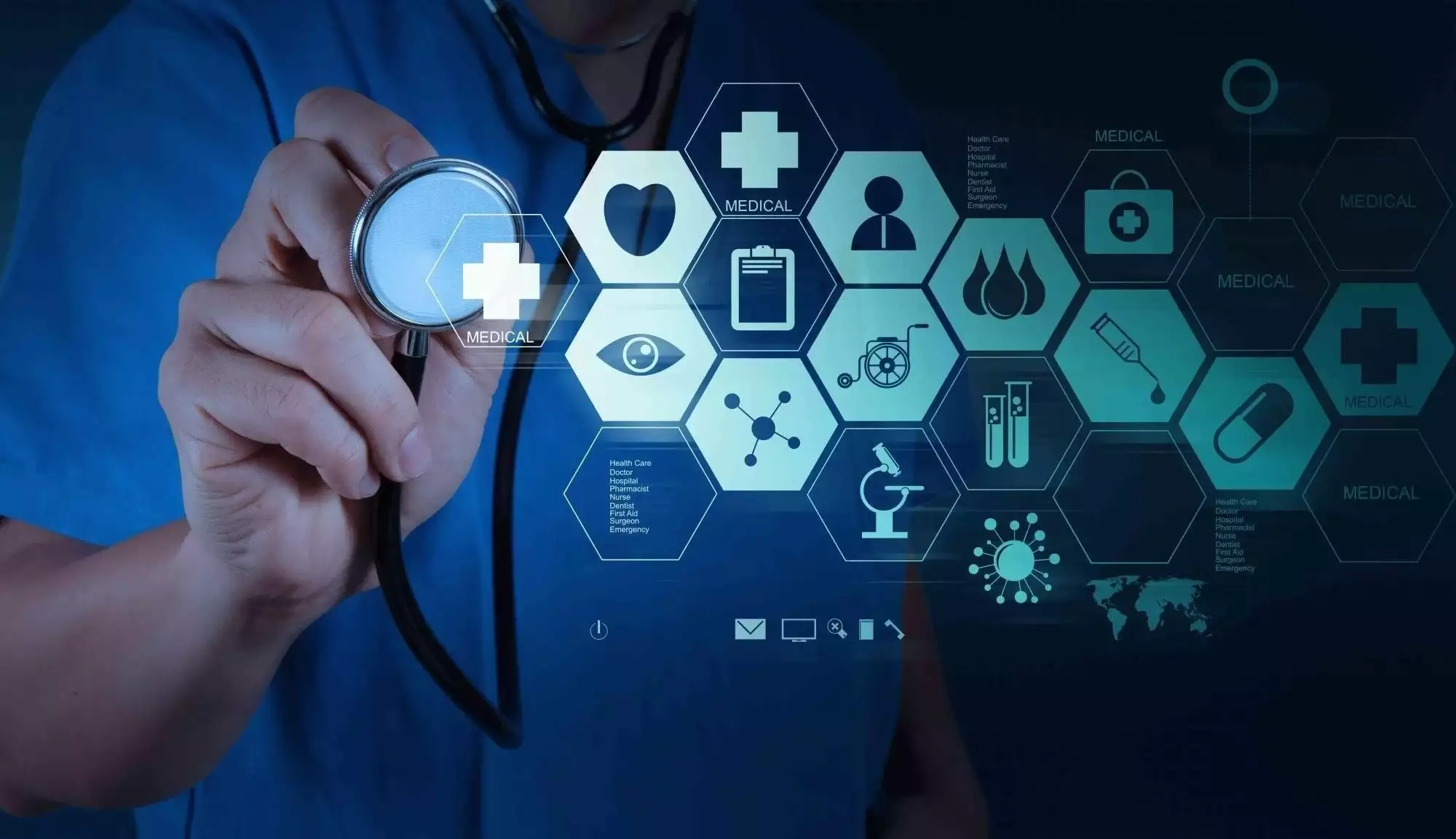Importance of Technology in Healthcare and Overview of Tools
Technology has revolutionized the healthcare industry, streamlining processes, enhancing patient care, and improving overall efficiency. Medical professionals now have access to a wide array of tech tools that aid in various aspects of their work, from diagnosis and treatment to record-keeping and communication.
The integration of technology in healthcare has become indispensable, offering numerous benefits. It enables faster and more accurate diagnoses, facilitates remote patient monitoring, and provides access to vast medical knowledge databases. Additionally, technology has enhanced collaboration among healthcare providers, allowing for seamless information sharing and coordinated care.
There are several categories of tech tools that medical professionals commonly utilize:
- Electronic Health Records (EHRs): These digital repositories store patient medical histories, test results, diagnoses, and treatment plans, ensuring easy access to comprehensive patient data.
- Medical Imaging and Diagnostic Tools: Advanced imaging technologies, such as CT scans, MRI machines, and ultrasound devices, provide detailed visualizations of internal structures, aiding in accurate diagnoses.
- Telemedicine and Remote Monitoring: Telemedicine platforms enable virtual consultations, allowing patients to receive care from the comfort of their homes, while remote monitoring devices track vital signs and health indicators, facilitating proactive interventions.
- Medical Apps and Software: A wide range of mobile applications and software programs assist medical professionals with tasks like drug reference, medical calculations, and treatment decision support.
- Surgical and Robotic Technologies: Robotic-assisted surgeries and advanced surgical tools have enhanced precision, minimized invasiveness, and improved patient outcomes in various medical procedures.
By embracing these tech tools, medical professionals can streamline workflows, reduce errors, and provide more personalized and efficient care to their patients.
Table of Contents
Electronic Health Records (EHRs)
Electronic Health Records (EHRs) are digital versions of a patient’s medical history, designed to streamline healthcare operations and enhance patient care. These sophisticated systems offer numerous benefits to medical professionals, ranging from improved data accessibility and legibility to enhanced collaboration and decision-making capabilities.
One of the primary advantages of EHRs is their ability to provide instant access to comprehensive patient information, including medical histories, diagnoses, treatment plans, and test results. This real-time data availability empowers healthcare providers to make informed decisions promptly, leading to more efficient and effective patient care. Additionally, EHRs eliminate the need for physical storage of voluminous paper records, reducing clutter and minimizing the risk of misplaced or lost files.
Popular EHR software solutions in the market include Epic, Cerner, Allscripts, and athenahealth, among others. These platforms offer robust features tailored to the unique needs of healthcare organizations, such as customizable templates, e-prescribing capabilities, and integrated billing and coding functionalities. Furthermore, many EHR systems seamlessly integrate with other healthcare technologies, enabling a streamlined workflow and enhanced data sharing among providers.
While the implementation of EHRs promises significant benefits, it is not without challenges. One of the primary hurdles is the substantial financial investment required for purchasing and deploying these systems, as well as the ongoing costs associated with maintenance, upgrades, and user training. Additionally, data privacy and security concerns arise, necessitating robust measures to safeguard sensitive patient information from unauthorized access or breaches.
Furthermore, the transition from traditional paper-based records to digital systems can be a complex and time-consuming process, requiring meticulous data migration and extensive staff training. Resistance to change and the learning curve associated with adopting new technologies can also pose obstacles, underscoring the importance of effective change management strategies and comprehensive user support.
Tech Tools for Enabling Remote Healthcare
Telemedicine platforms have become an essential tool for medical professionals, enabling remote consultations and care delivery. These secure, HIPAA-compliant platforms facilitate video conferencing, allowing doctors to evaluate patients, provide diagnoses, and prescribe treatments without the need for in-person visits. By leveraging telemedicine, healthcare providers can improve access to care, especially for patients in remote or underserved areas, while minimizing exposure risks during public health emergencies.
Wearable devices are revolutionizing healthcare by providing continuous monitoring and data collection capabilities. From fitness trackers that monitor vital signs like heart rate and sleep patterns to specialized devices for managing chronic conditions like diabetes, these wearables empower patients to take an active role in their healthcare journey. Medical professionals can leverage the data collected by these devices to gain insights into a patient’s health status, identify potential issues, and make more informed treatment decisions.
Remote patient monitoring systems are another game-changer in healthcare technology. These systems enable medical professionals to track a patient’s health indicators, such as blood pressure, blood glucose levels, and oxygen saturation, from a distance. By collecting and analyzing real-time data, healthcare providers can identify potential complications early, adjust treatments as needed, and reduce the need for frequent in-person visits. These systems are particularly beneficial for managing chronic conditions, post-operative care, and monitoring high-risk patients, ensuring timely interventions and improving overall patient outcomes.
Digital Imaging and AI-Assisted Diagnostics
Digital imaging technologies have revolutionized the medical field, enabling more accurate and efficient diagnosis and treatment. Medical imaging software, such as picture archiving and communication systems (PACS), allow healthcare professionals to store, retrieve, and analyze medical images like X-rays, CT scans, and MRI scans. These systems facilitate seamless collaboration among radiologists, physicians, and other medical staff, ensuring timely and accurate diagnoses.
Artificial intelligence (AI) has also made significant strides in medical imaging analysis. AI-assisted diagnostic tools can detect patterns and anomalies in medical images that may be missed by the human eye. These tools can help radiologists and physicians identify potential health issues earlier, leading to more effective treatment plans and improved patient outcomes.
Furthermore, AI-powered medical imaging software can streamline workflow processes, reducing the time and effort required for image analysis. By automating routine tasks, such as image segmentation and annotation, healthcare professionals can focus on more complex cases and provide personalized care to their patients.
Medical Reference Apps
Medical reference apps provide healthcare professionals with quick access to up-to-date information on diseases, drugs, procedures, and more. These apps serve as digital medical libraries, offering comprehensive and reliable data that can aid in diagnosis, treatment planning, and patient education.
One of the most widely used medical reference apps is Epocrates. This app offers a vast database of drug information, including dosages, interactions, and contraindications. It also provides clinical practice guidelines, disease monographs, and diagnostic tools. Epocrates is known for its user-friendly interface and regular content updates.
Another popular option is UpToDate, which is highly regarded for its evidence-based clinical decision support. This app provides in-depth information on various medical conditions, treatment options, and the latest research findings. It is particularly useful for complex cases and staying up-to-date with the latest medical advancements.
DynaMed is another valuable medical reference app that offers concise summaries of diseases, diagnoses, and treatments. It is known for its clear and well-organized content, making it easy for healthcare professionals to quickly find the information they need.
These medical reference apps are invaluable tools for healthcare professionals, enabling them to access critical information at the point of care, ultimately leading to better patient outcomes.
Virtual Reality (VR) Tools
Virtual reality (VR) is revolutionizing various aspects of healthcare, offering innovative solutions for pain management, surgical training, and patient education. This immersive technology transports users into simulated environments, providing unique opportunities for medical professionals to enhance their practices.
Pain Management: VR has emerged as a promising non-pharmacological approach to pain management. By immersing patients in captivating virtual worlds, VR can distract them from their pain and reduce the perception of discomfort. This technique has shown promising results in managing acute and chronic pain conditions, such as during wound dressing changes, physical therapy sessions, or post-operative recovery.
Surgical Training: VR simulations offer a safe and controlled environment for medical students and surgeons to practice complex procedures without putting patients at risk. These realistic simulations allow trainees to develop their skills, gain confidence, and experience various scenarios before entering the operating room. VR training can improve surgical proficiency, reduce errors, and ultimately lead to better patient outcomes.
Patient Education: VR can be an effective tool for educating patients about their conditions, treatments, and healthcare procedures. By providing immersive and interactive experiences, patients can better understand their medical journey and make informed decisions. VR can also be used to simulate scenarios related to rehabilitation or lifestyle changes, helping patients visualize and prepare for upcoming challenges.
Medical Imaging and Visualization Tools
Medical imaging and visualization technologies have revolutionized the field of healthcare, enabling doctors and surgeons to better understand and treat various medical conditions. These tools provide detailed, three-dimensional views of the human body, allowing for accurate diagnoses, precise surgical planning, and effective patient education.
One of the most significant advancements in this area is the use of prosthetics and surgical models. 3D printing technology has made it possible to create customized prosthetic limbs and implants tailored to each patient’s unique anatomy. These personalized devices not only improve functionality but also enhance comfort and aesthetics, greatly improving the quality of life for individuals with physical disabilities or injuries.
Moreover, 3D printing has enabled the creation of realistic surgical models that replicate specific patient conditions. Surgeons can practice complex procedures on these models before operating on the actual patient, reducing risks and improving surgical outcomes. These models are particularly valuable in intricate cases, such as congenital heart defects or intricate tumor removals, where precise planning is crucial.
Another groundbreaking development is organ printing, which holds immense potential for addressing the global shortage of donor organs. Researchers are exploring techniques to 3D print functional organs using a patient’s own cells, eliminating the risk of rejection and potentially saving countless lives. While still in its early stages, organ printing represents a promising frontier in regenerative medicine and could revolutionize organ transplantation in the future.
Electronic Health Records (EHR) Systems
Electronic Health Records (EHR) systems are essential tools for medical professionals, allowing them to securely store, access, and share patient data. HIPAA-compliant EHR platforms ensure the confidentiality and integrity of sensitive health information, utilizing robust data encryption and access controls. These systems streamline clinical workflows, facilitate accurate documentation, and enable seamless communication among healthcare providers.
EHR systems typically offer secure messaging capabilities, enabling healthcare teams to exchange patient information, consult on cases, and coordinate care while adhering to strict privacy and security protocols. Advanced features like e-prescribing, clinical decision support, and patient portals further enhance the efficiency and quality of care delivery.
Emerging Technologies in Medical Practice
The field of medicine is rapidly evolving, driven by groundbreaking technological advancements that are transforming the way healthcare is delivered. At the forefront of this revolution are emerging technologies like artificial intelligence (AI), machine learning, and personalized medicine, which are poised to revolutionize patient care and medical practices.
Artificial Intelligence (AI) and Machine Learning (ML) are playing an increasingly crucial role in medical diagnostics, treatment planning, and disease prevention. These advanced algorithms can analyze vast amounts of medical data, including patient records, imaging scans, and genomic information, to identify patterns and make accurate predictions. AI-powered systems can assist physicians in making more informed decisions, leading to earlier diagnoses, personalized treatment plans, and improved patient outcomes.
One of the most exciting applications of AI in medicine is in the field of medical imaging. AI algorithms can analyze X-rays, CT scans, and MRI images with unparalleled accuracy, detecting subtle abnormalities that may be missed by human radiologists. This technology has the potential to significantly improve the accuracy of diagnoses and reduce the risk of misdiagnosis.
Moreover, AI and ML are being leveraged in drug discovery and development processes, accelerating the identification of potential new therapies and reducing the time and cost associated with traditional drug development pipelines. Machine learning algorithms can analyze vast amounts of data, including molecular structures, biological pathways, and clinical trial data, to identify promising drug candidates and predict their efficacy and safety profiles.
Personalized medicine, also known as precision medicine, is another transformative approach that leverages advanced technologies to tailor medical treatments to an individual’s unique genetic makeup, lifestyle, and environmental factors. By analyzing a patient’s genomic data, healthcare providers can identify specific genetic variations that may influence disease risk, drug metabolism, and treatment response. This personalized approach can lead to more effective and targeted therapies, minimizing adverse reactions and improving overall treatment outcomes.
Electronic Health Records (EHR) Systems
Electronic Health Records (EHR) systems have become an essential tool for medical professionals, streamlining patient data management, improving care coordination, and enhancing overall efficiency. However, their adoption and implementation have faced several challenges:
Cost: Implementing an EHR system can be a significant financial investment for healthcare organizations, particularly smaller practices. The initial costs of purchasing the software, hardware, and training can be substantial, and ongoing maintenance and upgrades add to the long-term expenses.
Training: Transitioning from paper-based records to an EHR system requires comprehensive training for medical professionals and staff. Inadequate training can lead to frustration, errors, and resistance to adoption, hindering the system’s effectiveness and potentially compromising patient care.
Resistance to Change: Many medical professionals, accustomed to traditional paper-based methods, may resist the transition to EHR systems. This resistance can stem from concerns about workflow disruptions, data privacy and security, or a general aversion to new technologies.
Interoperability Issues: Lack of interoperability between different EHR systems can create challenges in sharing patient data across healthcare providers and facilities. This can lead to fragmented patient records, duplicated efforts, and potential medical errors, undermining the intended benefits of EHR systems.
Despite these challenges, EHR systems offer numerous advantages, including improved data accessibility, enhanced patient safety through reduced medication errors and better coordination of care, and increased efficiency through streamlined workflows. Addressing the cost concerns, providing adequate training, fostering a culture of change acceptance, and promoting interoperability standards are crucial steps in overcoming these obstacles and realizing the full potential of EHR systems in healthcare.
Technology’s Pivotal Role in Modern Healthcare and Looking Ahead
Technology has transformed the healthcare landscape, streamlining processes, enhancing patient care, and driving innovation. From electronic health records (EHRs) to telemedicine and advanced diagnostic tools, technology has become an indispensable ally for medical professionals. The seamless integration of technology into healthcare practices has not only improved efficiency but has also empowered healthcare providers to deliver more personalized and effective treatments.
As we look to the future, the role of technology in healthcare will continue to evolve and expand. Emerging technologies, such as artificial intelligence (AI), machine learning, and virtual reality (VR), hold immense potential for revolutionizing various aspects of healthcare, from disease prevention and early detection to personalized treatment plans and virtual training for medical professionals.
While technological advancements have brought numerous benefits, it is crucial to address ethical considerations, data privacy, and the need for ongoing training and adaptation. Embracing technology while prioritizing patient-centered care and maintaining the human touch will be essential for medical professionals in the years to come.



